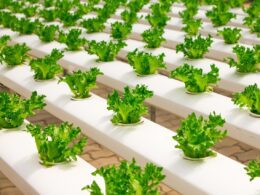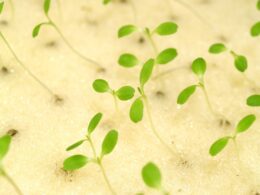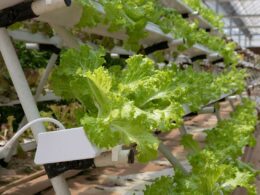Are you someone who values the safety and nutritional content of the food you consume? If so, you may be wondering whether lettuce grown in soil is better for you than hydroponic lettuce. The answer is not a simple one, as both methods have their pros and cons.
In this article, we will explore the differences between soil-based farming and hydroponic farming for growing lettuce, as well as the nutrient content and environmental factors that come into play. By the end, you will have a better understanding of which method may be the best choice for you and your family.
When it comes to choosing the right method for growing lettuce, it’s important to consider the quality of the food you are consuming. This means taking into account factors such as nutrient content and environmental impact.
While both soil-based farming and hydroponic farming have their benefits, it’s important to understand the differences between the two and how they may affect the food you eat. So, whether you’re a health-conscious individual or simply looking for the best way to grow your own lettuce, read on to discover which method may be the right choice for you.
Overview of Soil-Based Farming for Growing Lettuce
If you’re dreaming of growing your own veggies at home, you might want to consider soil-based farming as a great option for getting started. Soil-based farming involves growing plants in soil, which is the traditional method of farming.
Soil-based farming has several benefits, such as providing plants with a natural habitat that offers essential nutrients, water, and a stable environment to grow. Plants grown in soil are also more resistant to pests and diseases, which can save you money and time in the long run.
However, traditional soil-based farming also has its challenges. Soil-based farming requires significant amounts of space, water, and nutrients to grow plants successfully. Additionally, soil fertility can be affected by weather conditions, pests, and diseases, which can lead to lower yields. It can also be challenging to maintain the right balance of nutrients in the soil, which can affect plant growth and health.
Despite these challenges, soil-based farming remains a popular and effective way to grow lettuce. With proper planning and maintenance, you can enjoy fresh, healthy lettuce grown in your backyard.
Soil-based farming offers the satisfaction of growing your own food, providing you with a sustainable, environmentally friendly option for feeding your family.
Overview of Hydroponic Farming for Growing Lettuce
Hydroponic farming uses a nutrient-rich water solution to grow plants without traditional soil. This method is gaining popularity due to its efficiency in water usage and space-saving capabilities.
Vertical farming, a type of hydroponic farming, allows for multiple levels of crops to be grown in one space, making it ideal for urban agriculture.
Unlike soil-based farming, hydroponic farming allows for precise control over the nutrients and pH levels that the plants receive. This eliminates the need for pesticides and herbicides, making it a more environmentally friendly option.
Additionally, plants grown hydroponically tend to grow faster and yield more produce, which can be beneficial for commercial farmers and those looking to grow their own food at home.
Overall, hydroponic farming offers a unique solution to traditional farming practices. While it may not be the right fit for everyone, its benefits in water usage, space-saving, and precise nutrient control make it an attractive option for those in urban areas or with limited outdoor space.
Consider researching more about hydroponic farming to see if it could be a good fit for you.
Differences in Nutrient Content
When it comes to growing lettuce, there’s a lot of debate around the differences in nutrient content between soil-grown and hydroponically-grown crops.
Some argue that soil provides a wider range of nutrients, while others suggest that hydroponics can deliver more targeted and consistent nourishment.
Ultimately, the nutrients in your lettuce can have an impact on both the growth and health of your plants, as well as the preferences of your consumers.
Soil Nutrients vs. Hydroponic Nutrients
You’ll notice a distinct difference in the nutrient content between soil-grown plants and those grown hydroponically. Soil-grown lettuce receives its nutrients from the organic matter in the soil, while hydroponic lettuce is fed synthetic nutrients dissolved in water.
Organic nutrients in soil are absorbed by the plant roots, which then break them down into simpler substances. This process allows the plant to extract all the necessary nutrients it needs to grow healthy and strong. On the other hand, hydroponic nutrients are already in their simplest form, which means the plants do not need to break them down, and can readily absorb them.
The difference in nutrient content between soil-grown and hydroponic lettuce can affect its taste, texture, and overall quality. Soil-grown lettuce tends to have a more complex and richer flavor, while hydroponically grown lettuce can have a more neutral taste. Additionally, soil-grown lettuce tends to be more nutrient-dense, due to its ability to absorb a wider range of nutrients from organic matter.
However, hydroponic lettuce can still be nutrient-rich, especially if the synthetic nutrients are carefully formulated and balanced to meet the plant’s needs. Ultimately, the choice between soil and hydroponics depends on personal preference, as well as factors such as space, time, and resources available for growing.
Impact on Plant Growth and Health
If you want your plants to thrive and stay healthy, it’s crucial to choose the right growing method. When it comes to lettuce, the impact of soil vs. hydroponics on plant growth and health is significant.
One of the main differences is the effect on taste and nutritional value. While both methods can produce nutritious lettuce, soil-grown lettuce has a distinct flavor that many people prefer. This is because soil provides a complex mix of nutrients, including minerals, organic matter, and microorganisms, which all contribute to the plant’s growth and flavor. Hydroponic lettuce, on the other hand, is grown in a controlled environment with a precise mix of nutrients, which can result in a more uniform flavor but may lack the depth and complexity of soil-grown lettuce.
Another factor to consider when choosing between soil and hydroponic lettuce is the comparison of yield and cost. While hydroponic systems can produce higher yields and more consistent crops, they require a significant investment in equipment and technology. Soil, on the other hand, is a more affordable and accessible option for many growers. However, soil-grown lettuce may have more variability in yield and quality due to factors such as soil type, climate, and pests.
Ultimately, the choice between soil and hydroponic lettuce depends on your priorities as a grower and consumer. Whether you prioritize taste, nutritional value, yield, or cost, it’s important to weigh the pros and cons of each method and choose the one that best fits your needs.
Consumer Preferences
As a savvy consumer, you’ll want to consider your personal preferences when it comes to the taste and nutritional value of your greens, as well as the consistency and cost of production methods.
Some people prefer the taste and texture of lettuce grown in soil, while others prefer the crisp, clean taste of hydroponic lettuce. Additionally, some consumers prioritize organic produce, while others are satisfied with conventionally grown produce. Keep in mind that the nutritional value of lettuce can vary depending on the growing method and the soil quality.
When it comes to production methods, some consumers prefer to buy local produce to support their community and reduce their carbon footprint. However, others may prioritize cost and choose to buy imported lettuce. It’s important to consider the potential impacts of transportation on the environment and the freshness of the product.
Ultimately, the decision of whether to choose lettuce grown in soil or hydroponically, and whether to prioritize organic or conventionally grown produce, is up to your personal preferences and values.
Environmental Factors
When it comes to environmental factors in lettuce farming, there are three key points to consider.
First, let’s talk about water usage and conservation. You may be interested to know how much water is needed for hydroponic lettuce compared to soil-grown lettuce.
Next, let’s consider the carbon footprint of lettuce farming. How much energy is used to power indoor farming systems?
Finally, let’s look at land use and space efficiency. The amount of land needed for traditional farming versus vertical farming can also be compared.
By exploring these factors, you can gain a better understanding of the environmental impact of different lettuce farming methods.
Water Usage and Conservation
Conserving water is a crucial aspect to consider when growing crops. It’s important to use irrigation techniques that are efficient and don’t waste water.
Hydroponic systems, although they use less water overall, require a constant flow of water to maintain the plants. This means that if there’s a leak or malfunction in the system, water can be wasted quickly. Additionally, hydroponic systems often require the use of purified water, which can be a waste of resources if the water isn’t recycled or reused.
In contrast, lettuce grown in soil can be watered using drip irrigation or other efficient techniques that conserve water. Soil can also act as a reservoir, holding onto moisture and releasing it slowly over time. This means that less water is needed overall and the plants are still able to thrive.
Overall, when it comes to water usage and conservation, lettuce in soil may be a better option than hydroponics.
3 Tips for Conserving Water in Lettuce Growth:
- Use drip irrigation or other efficient watering techniques to minimize water waste.
- Consider using soil as a natural reservoir for moisture.
- If using hydroponics, make sure to properly maintain the system and recycle or reuse purified water to avoid wasting resources.
Carbon Footprint
Reducing your carbon footprint is an important consideration when growing crops, whether in soil or hydroponically. While hydroponic systems may use less water, they often require more energy to power pumps and lighting. Additionally, the materials used in hydroponic systems, such as plastic tubing and grow trays, have a higher carbon footprint than traditional soil farming equipment.
To offset this carbon footprint, many hydroponic farmers are incorporating sustainable practices into their operations. For example, some are using renewable energy sources like solar or wind power to power their systems. Others are using compostable materials or recycled plastics for their equipment.
Additionally, some hydroponic farms are partnering with carbon offsetting programs to help neutralize their impact on the environment. By making these changes, hydroponic farmers can continue to grow crops efficiently while minimizing their carbon footprint.
Land Use and Space Efficiency
Land use optimization is crucial in modern agriculture, especially with the increasing demand for food and limited arable land. Urban farming initiatives have gained popularity in recent years, and hydroponics is one of the most efficient ways to grow crops in a limited space.
With hydroponic systems, you can grow more crops per square foot compared to traditional soil-based farming. Here are three ways hydroponics maximizes land use and space efficiency:
-
Vertical Farming: Hydroponic systems allow for vertical farming, where crops are grown in stacked layers. This method significantly increases the number of crops that can be grown per square foot, making it an excellent option for urban areas with limited space.
-
Recirculation: Hydroponic systems use recirculation, which means that water and nutrients are reused, reducing water usage by up to 90%. This method also eliminates the need for soil, which takes up a lot of space.
-
Controlled Environment: Hydroponic systems provide a controlled environment, where temperature, humidity, and light can be optimized for maximum crop growth. This method eliminates the need for farmland and allows for year-round crop production.
Overall, hydroponic systems offer unique solutions to maximize land use and space efficiency. With the increasing demand for food and limited arable land, hydroponics is a promising option for urban farming initiatives.
Choosing the Right Method
When choosing the right method for lettuce farming, there are several factors to consider. Your personal preferences and priorities play a big role in this decision-making process.
Additionally, it’s important to keep future trends in mind as lettuce farming continues to evolve.
Factors to Consider
Let’s explore some important factors to keep in mind when deciding on the best method for growing your greens. Here are some key points to consider:
-
Cost considerations: Hydroponic systems tend to be more expensive than traditional soil-based methods. You’ll need to decide whether the cost is worth it for the potential benefits.
-
Health benefits: While both methods can produce healthy lettuce, soil-grown lettuce may contain more beneficial bacteria and nutrients that can help support overall health.
-
Space: Hydroponic systems can be more compact and efficient, making them a good choice for small spaces. However, soil-based methods may be better suited for larger gardens or outdoor spaces.
-
Maintenance: Hydroponic systems require more maintenance and monitoring than soil-based methods. You’ll need to regularly check pH levels, nutrient levels, and water quality to ensure your plants are healthy.
-
Environmental impact: Hydroponic systems use less water and can produce crops year-round, making them more environmentally friendly. However, soil-based methods may be better suited for certain climates and can help support local ecosystems.
Consider these factors when deciding on the best method for growing your greens.
No matter which method you choose, be sure to research and follow best practices for optimal results.
Personal Preferences and Priorities
Now that you’ve considered the various factors that affect the growth and quality of lettuce in soil and hydroponics, it’s time to think about your own personal preferences and priorities.
When it comes to growing conditions, do you have a preference for natural sunlight and soil, or are you more interested in the controlled environment and efficiency of hydroponics?
Your taste preferences also play a role in this decision. Some people believe that lettuce grown in soil has a richer flavor, while others find that hydroponic lettuce is more consistent and has a milder taste.
Ultimately, the choice between soil and hydroponics comes down to what matters most to you, whether it’s taste, efficiency, or environmental impact.
So, take some time to consider your own priorities and make a decision based on what works best for you.
Future Trends in Lettuce Farming
The future of farming is looking towards more efficient and sustainable methods that utilize controlled environments and technology. One such method that’s gaining popularity in the lettuce farming industry is vertical farming. This method involves growing crops in stacked layers, using artificial lighting and controlled temperature and humidity levels. Vertical farming allows for higher crop yields in a smaller space, making it an attractive option for urban areas where space is limited.
Automation is also playing a big role in the future of lettuce farming. With the use of robotic arms and sensors, lettuce can be harvested and sorted more efficiently, reducing the need for manual labor. This not only saves time and money, but also reduces the risk of contamination from human handling.
Overall, the future of lettuce farming looks promising with the use of vertical farming and automation, allowing for a more sustainable and efficient way of growing crops.
Frequently Asked Questions
What are the potential health risks associated with consuming lettuce grown in soil versus hydroponics?
As a health-conscious consumer, you may wonder about the potential health risks associated with consuming lettuce grown in soil versus hydroponics.
One concern is the potential contamination of soil-grown lettuce with harmful bacteria such as E. coli or salmonella, which can cause foodborne illness. Hydroponically grown lettuce, on the other hand, is less likely to be contaminated with these pathogens as it is grown in a controlled environment without soil.
However, some studies suggest that soil-grown lettuce may contain more nutrients, such as antioxidants and minerals, compared to hydroponically grown lettuce.
Ultimately, both methods of growing lettuce have their pros and cons, and it’s up to you to decide which option best fits your priorities and needs.
How does the taste and texture of lettuce grown in soil compare to that of hydroponically grown lettuce?
When it comes to comparing the taste and texture of lettuce grown in soil versus hydroponics, there are a few factors to consider.
Many people believe that soil-grown lettuce has a richer, more complex flavor compared to the milder taste of hydroponic lettuce. However, hydroponic lettuce tends to have a more consistent texture and crunch.
In terms of nutrient content, both types of lettuce can be just as nutritious as long as they’re grown with proper care and attention.
When it comes to sustainability and environmental impact, hydroponics is often seen as the more environmentally friendly option due to its reduced water usage and lack of soil erosion. However, consumer preferences and buying habits can vary, so it ultimately comes down to personal preference.
What is the cost difference between soil-based farming and hydroponic farming for growing lettuce?
When it comes to growing lettuce, the cost comparison between soil-based farming and hydroponic farming is an important factor to consider. While hydroponics may have a higher upfront cost for equipment and infrastructure, it can often lead to greater yields and faster growth rates.
On the other hand, soil-based farming may require less initial investment, but may require more labor and resources in the long run. Additionally, hydroponic farming can have a lower environmental impact, as it uses less water and doesn’t require soil.
Ultimately, the choice between soil-based farming and hydroponic farming will depend on your specific situation and goals.
Can soil-based farming and hydroponic farming be used together to grow lettuce?
If you’re looking to optimize your lettuce growing, consider soil hydroponic integration. This method combines the benefits of both soil-based farming and hydroponic farming to improve nutrient uptake efficiency.
By using a combination of both systems, you can create a more stable and resilient growing environment for your lettuce. Plus, it allows for greater control over growing conditions and can help reduce the risk of crop failure.
With soil hydroponic integration, you can achieve a higher yield and a more consistent quality of lettuce. So, instead of choosing between soil-based farming or hydroponic farming, why not use both together for optimal results?
What are the most common pests and diseases that affect lettuce in soil-based farming and hydroponic farming?
When it comes to lettuce farming, there are a few pesky pests and diseases to watch out for. Aphids and slugs are common culprits, as well as fungal diseases like powdery mildew.
Prevention is key, so make sure to keep your lettuce plants well-ventilated and don’t overcrowd them. If you do notice an infestation, there are organic and chemical treatments available, but be aware of the potential drawbacks of using pesticides.
While they can be effective in controlling pests and diseases, they also come with environmental and health risks. Ultimately, it’s up to you to weigh the benefits and drawbacks and decide what’s best for your lettuce crop.
Conclusion
So, is lettuce in soil better than hydroponics? Well, it depends on what factors are most important to you.
Soil-based farming for growing lettuce has been around for centuries and is a tried-and-true method. With soil-based farming, you get the benefit of natural nutrients and minerals that are present in the soil. However, this method can be more labor-intensive and require more space.
On the other hand, hydroponic farming for growing lettuce is a modern method that is gaining popularity. With hydroponics, you have more control over the environment and can potentially grow more lettuce in a smaller space. However, some argue that the nutrient content of hydroponically grown lettuce is not as high as soil-grown lettuce.
Ultimately, the decision of whether to grow lettuce in soil or hydroponics is up to you. Consider factors such as nutrient content, environmental impact, labor requirements, and space limitations when making your decision.
Both methods have their pros and cons, so it’s important to choose the one that aligns with your goals and values.








